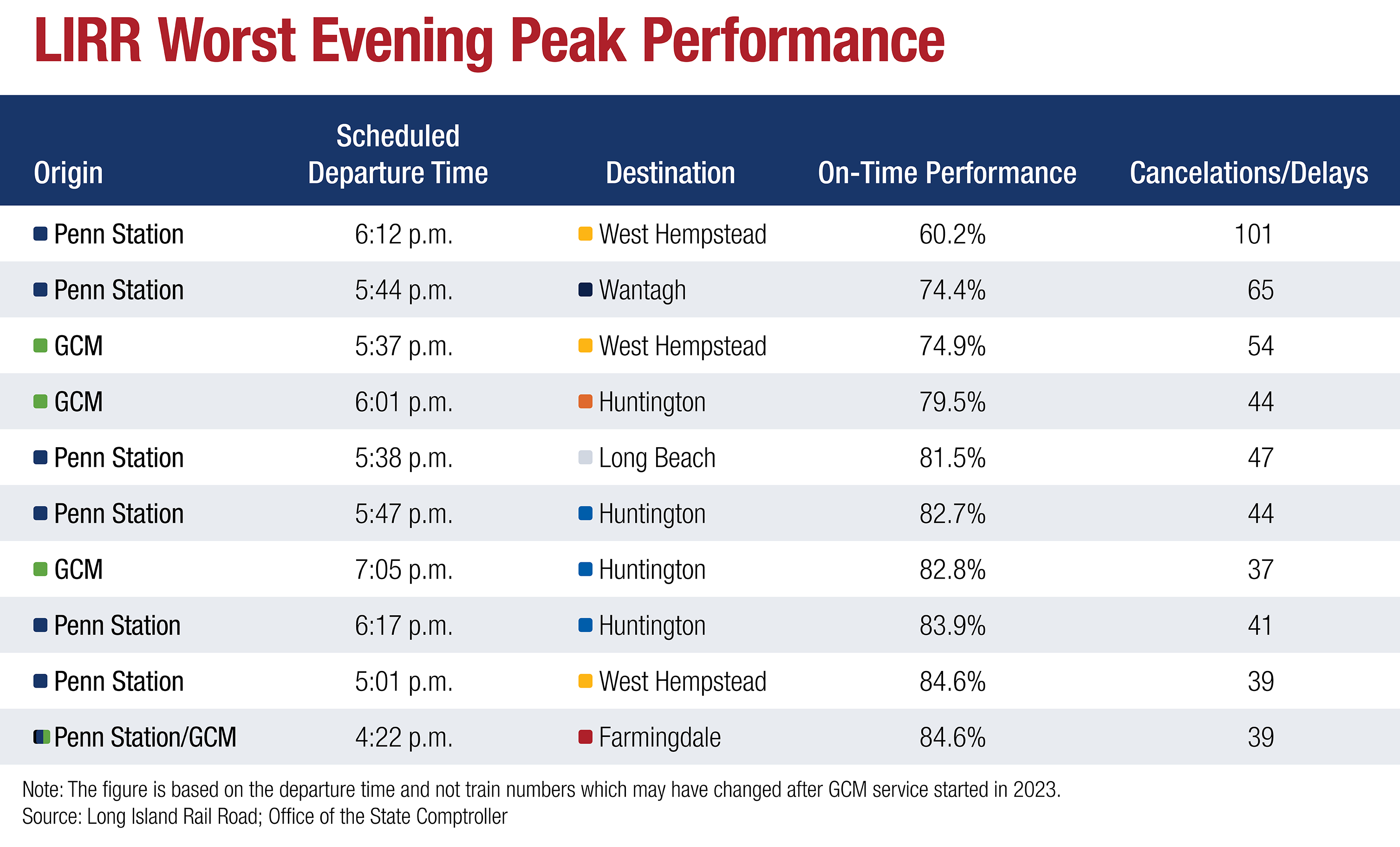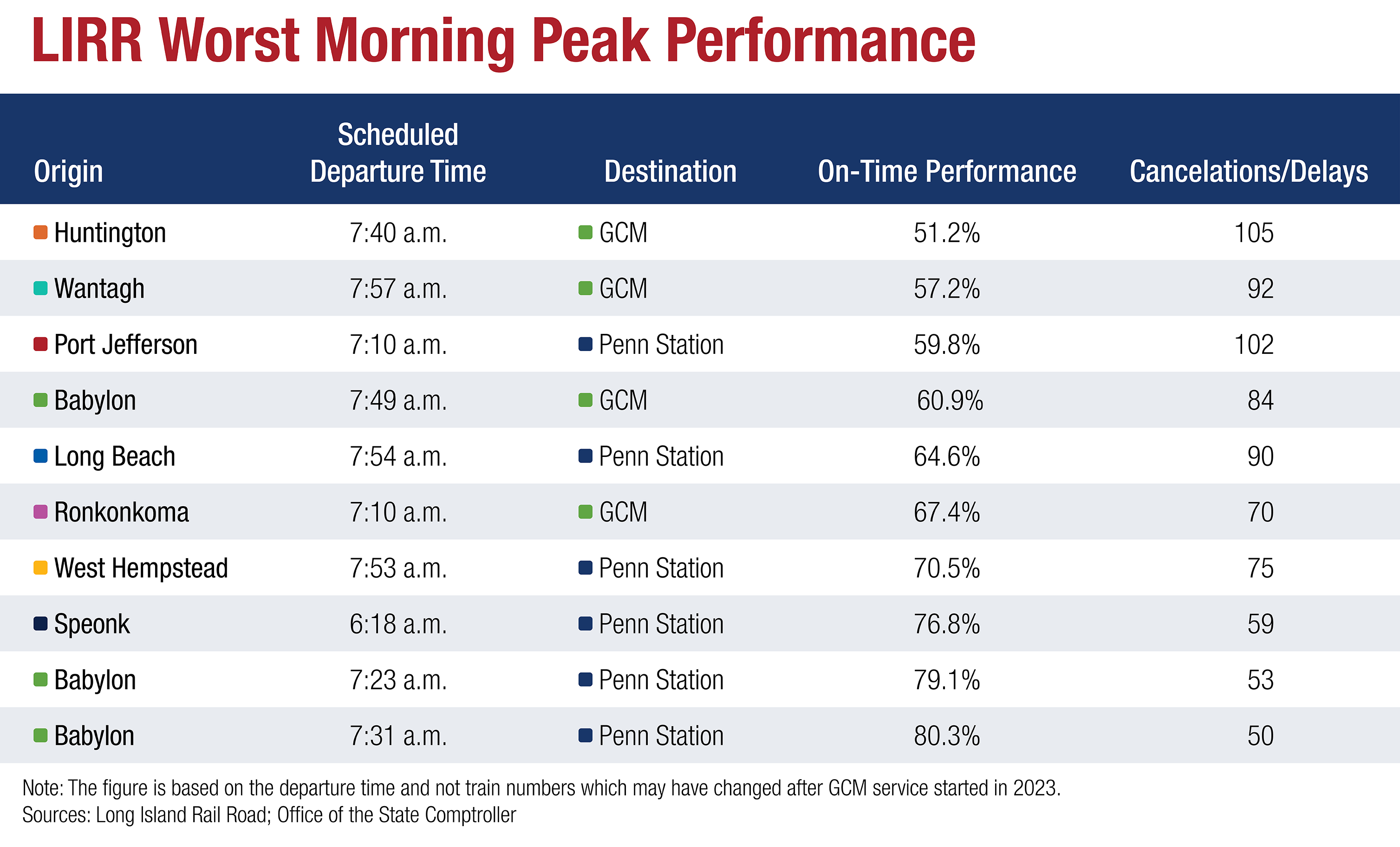The Long Island Rail Road (LIRR) is making a steady recovery from the pandemic with growing ridership, increased service routes into the Grand Central Madison terminal and on-time performance in 2023 that was better than in 2019. Still, the LIRR had 31% more delays from train car problems last year than in 2019, showing there are still areas that can improve as ridership returns, a new report from State Comptroller Thomas P. DiNapoli shows.
“The LIRR has made improvements in on-time performance since the pandemic devastated New York’s public transportation system,” DiNapoli said. “The recent rise in train delays and cancellations, especially from train problems, is troubling, however, because it comes at a time when LIRR needs good service to help convince riders to come back.”
LIRR’s 65.2 million riders in 2023 were 23% fewer than its 2019 pre-pandemic peak of 91.1 million, but reflected consistent growth from the 52.5 million riders in 2022 and 35 million in 2021. To meet this growing demand LIRR scheduled 303,519 trains in 2023 which was 77,453 more than in 2022.
LIRR considers trains on-time if they arrive less than six minutes past their scheduled arrival. For 2023, LIRR reported 93.9% of its trains were on time, or not delayed. However, delays in 2023 increased by 96 percent compared to 2022 as service increased 34% and ridership increased 24%. There were 17,064 late trains systemwide, including 2,465 that were more than 15 minutes late and 14,599 that were less than 15 minutes late. Total delays did represent a slight improvement over the 17,682 late trains in 2019. DiNapoli’s report estimates the average late train was 11.2 minutes late in 2023. The longest delay of 2023 was just over three hours due to a police action.
DiNapoli’s report also notes that LIRR’s measure for late trains may not reflect some riders’ experience as a delay of just a few minutes can result in a missed connection or other problems. For example, if trains had to arrive within four minutes of their scheduled time, instead of six minutes, to be rated on-time, then on-time performance would decline to 79.9%.
In 2023 there were also 742 trains canceled at the terminal before departing and another 559 were taken out of service, or terminated, while on a route. There are many reasons trains can be delayed, canceled, or terminated. In 2023, LIRR was responsible for nearly one-in-three (5,883) of the total 18,365 trains affected in this way, down 11% from 2019. More than 93% of the problems were caused by mechanical problems or infrastructure maintenance issues.
Although LIRR improved on the number of delays, cancellations, and terminations that were in its control compared to 2019, the number of incidents caused by train problems increased 31%. This higher incidence of train problems may be alleviated by faster procurement and delivery of new train cars. DiNapoli has reported the average age of the LIRR’s fleet has increased from 12 years old in 2013 to 18 in 2022 as delivery has been delayed.
The MTA recently announced it would have to reduce the size of its 2020-2024 capital program by $15 billion, including an estimated $1.5 billion at the LIRR, due to the pause of the start of congestion pricing. Given the MTA’s new focus on funding state of good repair projects, the funding of new train cars may be delayed even further, leading to more delays from train car problems. DiNapoli’s report recommends the MTA increase its preventive maintenance of older train cars to ensure that on-time performance does not slip from its current high level.
State law requires the LIRR to report each month the percentage of trains that arrive from four minutes to five minutes and 59 seconds after their scheduled arrival time. DiNapoli’s report recommends LIRR provide additional detail, including trains’ origin, destination and line. These are details it already provides for trains that are late according to its six minute standard and would provide a more complete picture of riders’ experience. OSC also recommends developing an operating metric to measure how often trains are late for their connection with another train.
Report
Long Island Rail Road: On-Time Performance by the Numbers


